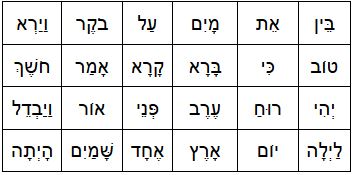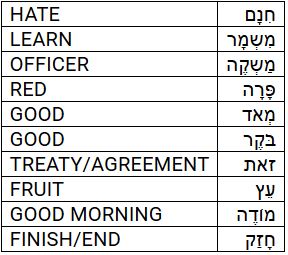 After my recent post about how weak kriah can mask a more significant language processing issue, I was asked how a parent can tell if their child has a more significant issue than kriah.
After my recent post about how weak kriah can mask a more significant language processing issue, I was asked how a parent can tell if their child has a more significant issue than kriah.
Here are some ideas that parents can do in order to determine if more professional help is called for:
THE VOCABULARY CHALLENGE
Give your child the following two activities to do:
- Ask your child to translate the following list of words.How many of the incorrect answers that are listed below were given? Why do you think they made these mistakes? It might be from rote learning of passukim and association with familiar ideas or it might indicate a language processing weakness.
- Choose the shorashim of common words in four passukim that your child learned around two weeks ago and put them in a random order. First, ask the child to translate the passukim. Then, ask him to translate the list of words. For example, the first four passukim in בראשית would look like this:

Can he identify individual words that are out of context and not part of a larger phrase? You might discover that he has some difficulty translating individual words even if they can be translated correctly in context. In addition, he might confuse words with similar sounding words or with other words in a familiar phrase. As in the first exercise, weak performance on this exercise can be due to the type of classroom instruction or it might be attributed to a language processing weakness. How can you tell where the problem comes from? The next section will explain why children can make such mistakes even if they have no intrinsic learning disabilities.
THE PROBLEM WITH TRANSLATING BY PHRASES
Many teachers translate passukim in small phrases by rote. This is especially true in the younger grades in which rote learning by phrases is the predominant form of instruction in many schools. While it is important to teach the students how words are connected in order to construct proper meaning and to teach comprehension, there is nevertheless an inherent shortcoming in translating words only in phrases.
When Chumash is taught only by phrases, the meaning of individual words is often not mastered and individual words are often confused with other words in the phrase. Another problem is that the rote style learning that is prevalent in the younger grades can often conceal the actual weaknesses of a child. A child with a good memory can rapidly repeat back the phrases that he learned by rote. The parents and teachers are content that the child knows the material that he has learned. However, when the rote learning stops in around the third or fourth grade, the child suddenly starts to have trouble in Chumash.
This phenomenon is potentially even more of a concern in schools that tiche in Yiddish to children whose native language is not Yiddish. Unless the children are taught the meaning of the Yiddish words as well, they are likely to misunderstand the meaning of the Yiddish words. It is therefore imperative to isolate the meaning of each individual word in a way that the child will comprehend and process the word in a language that he understands. In summary, while translating by phrases is an important part of the instructional process, ultimate success requires focusing on the meaning of individual words as well.
SO HOW CAN A PARENT KNOW WHERE THE UNDERLYING PROBLEM IS?
It is a matter of frequency and degree. If a child is basically picking up the meaning of individual words and only periodically makes mistakes, there is most likely not a real concern. However, if the child is frequently confusing individual words, cannot translate them at all, or is frequently confusing conceptually or phonetically related words, then a cautious parent should consider further testing. Before you spend a lot of money on testing, there is another free exercise you can give your child.
The Chumash Vocabulary Test is a diagnostic test that I developed to assess frequent Chumash word achievement. It contains approximately 64% of all the frequent words in Chumash. The test can be taken for free online at https://testmoz.com/604546. A typical Lakewood type cheder student should be able to score around 85-90% on the test by the end of 2nd grade or 3rd grade. Lower scores might be due to instruction only by rote, but scores less than 70% are a red flag that there is a real issue that is not just because of rote instruction. If a child scores less than 70%, it is time to get professional testing and help for your child. Hashem should help that all our children will succeed in acquiring the necessary textual skills to learn Torah. It is our role to daven for our children and to get them help when they are not succeeding.
Rabbi Yaakov Aichenbaum teaches kriah, Chumash, and Gemara to individuals with learning difficulties in Baltimore and online to students around the world. Rabbi Aichenbaum welcomes your comments & questions.
Rabbi Yaakov Aichenbaum

